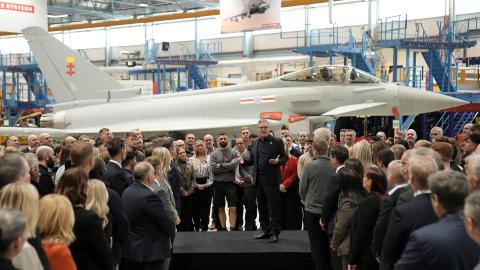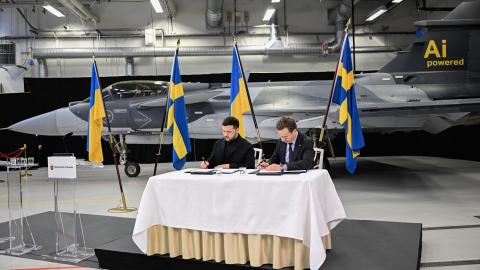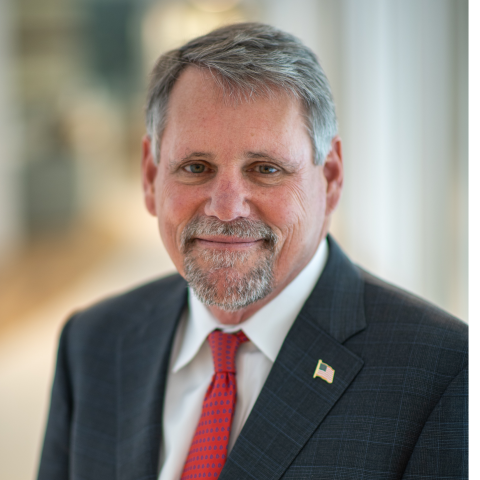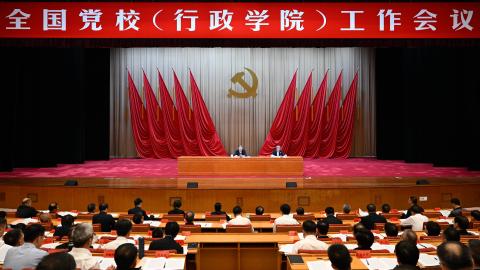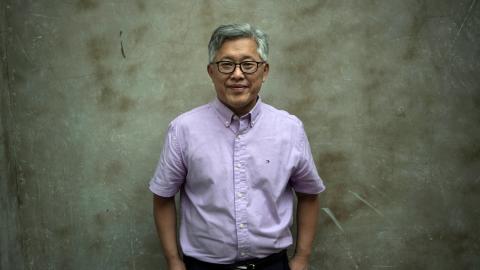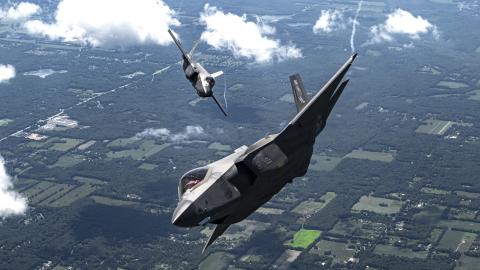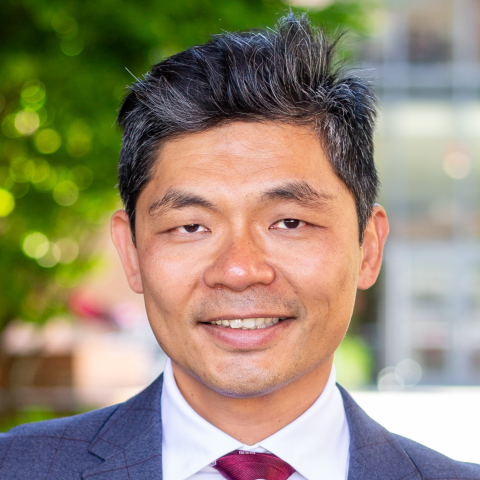
Strengthening the Allied Industrial Base
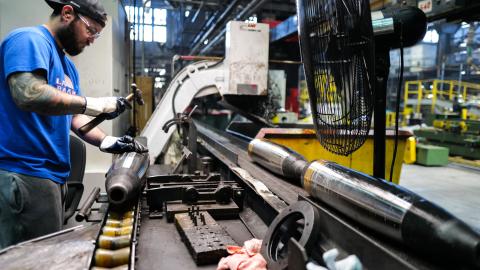

United States Representative, First District of Virginia

Ambassador of the Republic of Korea to the United States

Senior Advisor to the Secretary of the Navy
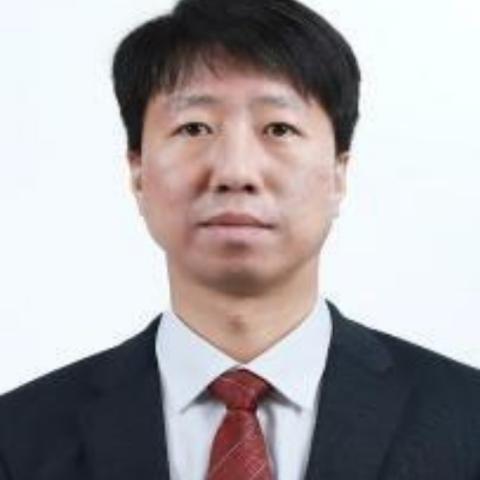
Head of Design and Engineering, HD Hyundai Heavy Industries

Senior Vice President and Deputy Managing Director, American Rheinmetall Vehicles
Deputy to the Deputy Assistant Secretary of the Army for Defense Exports and Cooperation
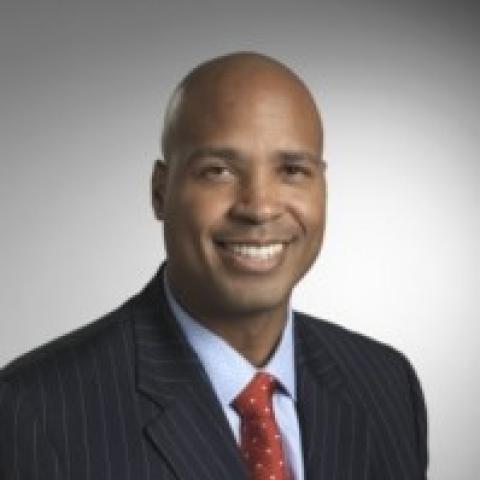
Chief Executive Officer, Hanwha Defense USA

Chief Innovation Officer, Saab Inc.

Senior Fellow
Nadia Schadlow is a senior fellow at Hudson Institute and a co-chair of the Hamilton Commission on Securing America’s National Security Innovation Base.

Senior Fellow, Center for Defense Concepts and Technology
Timothy A. Walton is a senior fellow at Hudson Institute, supporting the work of the Center for Defense Concepts and Technology.
Wars in Eastern Europe and the Middle East and the rising threat of conflict in Asia demonstrate that American and allied militaries need to increase the scale and adaptability of their defense production. Deployed forces are emptying their munitions magazines, and allied demand for ships and aircraft far outstrips supply. Meanwhile, technology proliferation allows adversaries to render legacy weapons systems obsolete. The United States and its allies will need to combine their industrial efforts to keep pace with these dynamic and intensifying security challenges.
Join Hudson Senior Fellows Timothy Walton and Nadia Schadlow for an event exploring the opportunities and challenges in implementing a more unified allied industrial base with Representative Rob Wittman (R-VA), Ambassador Hyun-dong Cho of South Korea, senior US Navy and Army officials, and leaders of major Asian and European defense firms.
Agenda
9:00 a.m. | Opening Remarks
- Ambassador Hyun-dong Cho, Ambassador of the Republic of Korea to the United States
9:20 a.m. | Panel 1
- Steve Brock, Senior Advisor to the Secretary of the Navy
- Sang-bong Lee, Head of Engineering and Design, HD Hyundai Heavy Industries
- Jim Schirmer, Senior Vice President and Deputy Managing Director, American Rheinmetall Vehicles
Moderator
- Nadia Schadlow, Senior Fellow, Hudson Institute
10:00 a.m. | Panel 2
- Michael Kuenzli, Deputy to the Deputy Assistant Secretary of the Army for Defense Exports and Cooperation
- Mike Smith, Chief Executive Officer, Hanwha Defense USA
- Rob Murray, Chief Innovation Officer, Saab Inc.
Moderator
- Timothy Walton, Senior Fellow, Center for Defense Concepts and Technology, Hudson Institute
10:45 | Fireside Chat
- Representative Rob Wittman, United States Representative, First District of Virginia
- Nadia Schadlow, Senior Fellow, Hudson Institute
Event Transcript
This transcription is automatically generated and edited lightly for accuracy. Please excuse any errors.
Nadia Schadlow:
Welcome, everyone. Hudson is known for starting on time, so we’re going to do that today. And it is a pleasure to be here this morning and I’m very grateful for those of you who are here in person and those of you listening online. We have here today representatives from the United States and some of our closest allies and partners. We’re here because unfortunately, with the wars in the Middle East and Europe, we’ve been reminded that we must be prepared to protect our interests with military force should deterrence fail. And we have seen what happens when deterrence fails: tragedy, death, destruction. And both of these conflicts have shown us in real time the importance of scale and adaptability and cooperation in defense production. Allies are emptying their munitions stockpiles, demand for deployed ships and aircraft outstrip supplies, demand for, as I said, munitions. At the same time, the proliferation of technology has allowed our adversaries to render longstanding weapon systems, if not obsolete, at least degraded in their capabilities. Allies will need to combine their industrial efforts to keep pace with dynamic and intensifying security challenges. And that’s the subject of today’s morning, looking at how we might improve and strengthen and add to allied defense cooperation.
We have an excellent lineup. We’re going to start the morning with the ambassador from the Republic of Korea, and then we’ll shift to two panels of experts and we’ll end the morning with a fireside chat virtual with Representative Rob Wittman. I’ll turn to our first speaker this morning. I have the pleasure of introducing one of our most stalwart allies and deeply knowledgeable diplomat, Ambassador Cho Hyun-dong. Ambassador Cho serves as the 28th ambassador of the Republic of Korea. He has a long and illustrious career. He served in India, Austria, at the United Nations. He represents a country that has long understood the importance of a strong defense establishment and a strong defense industrial base. He’s been personally a part of the key US-Korea bilateral relationship and has been at the forefront of working with our countries together to relook at supply chains and to navigate increasing competition across the technology sectors.
Most recently, he has played a central part in building on the Camp David meeting of last year with trilateral cooperation among the United States, Japan, and Korea, and he’s an expert on North Korea and has worked for many years with the United States to enhance our capabilities to address Pyongyang’s increasing provocations. Ambassador Cho most recently is working with President Yoon on his global pivotal state initiative. Maybe we’ll hear a little bit about that, and it’s a great privilege to welcome him this morning. Thank you so much, Ambassador.
Ambassador Hyun-dong Cho
Well, good morning everyone. Thank you Nadia, for your kind introduction. Well, first thank you to Hudson Institute for hosting today’s forum. I’m so delighted to join you and pleased that leading Korean companies are represented here today as well, along with many of our European friends. Well, to me, this week is truly a week of defense industry.
On Tuesday, I had the pleasure of visiting the AUSA 2024 annual meeting and expedition to see the exciting ways the modern technologies being deployed to advance military equipment. The Korean Pavilion in particular has an exceptional display of fascinating product produced by the Korean defense industry.
As our global economic partnership continues to flourish, the companies here today have played an instrumental role in developing key industries and advancing cutting-edge technologies here in the United States. We are at the pivotal moment in global security. Each morning, we wake up to news of strikes and bombardment in Middle East, Russian or Ukrainian advancement on battlefield, North Korean soldiers on the Russian front in Ukraine, or China’s aggressive air and sea maneuvers nearby. Russia’s invasion of Ukraine reminded us how vulnerable nations are to their aggressive neighbors and brought renewed attention to the importance of conventional weapons. Despite our many technological advances, they remain very relevant in modern warfare alongside new high-tech weapons like FPV suicide and dragon drones.
At the same time, the strategy competition between the United States and China is intensifying. And some specific countries as well as terrorist organizations continue to strengthen global peace and security. Together, these factors clearly demonstrate the need for stronger defense industrial cooperation among allies and partners. Russia’s reliance on North Korea for arms supply underscores how interconnected security concerns are in Indo-Pacific and Euro-Atlantic regions. Moreover, North Korea demonstrates yet another display of hostility earlier this week by blowing up the road that used to connect north and south. While mostly symbolic, this demonstrates how Pyongyang willfully established itself a menace in two theaters either side of the globe. It is vital that industries from Korea, Europe and the United States come together to strengthen our collaboration and enhance our defense capabilities. Only that will ensure an effective and coordinated response to many challenges to global peace and security we face. That is why today’s event is so important.
Although there are many ways our nations can cooperate, I want to focus first on shipbuilding, which has always been a significant element of global strategic competition. The US Congress recently released a report highlighting the disparity in the shipbuilding capacity between the United States and China. To be blunt, it found that China is far ahead. Right now, China has 230 times the shipbuilding capacity of the United States, while also possessing the world the largest maritime fighting force operating 234 warships to the US Navy’s 219. The great 19th century naval historian Alfred Thayer Mahan famously said, “Whoever rules the waves rules the world.” So if history is any guide, this disparity could easily impact global power dynamics. The good news is that there’s a strong bipartisan support in the US to address this challenge. The bad news is that by working together, the capacity exists for Korea and United States to build a stronger industrial foundation and one that will jointly support our friends and allies national security and economic prosperity.
Korea is the world’s second-largest shipbuilding country with a 30 percent market share and a reputation for efficiency and excellence. Navy Secretary Carlos del Toro visited Korea’s shipyard earlier this year to see our swift and cost-efficient shipbuilding, as he mentioned himself during his speech at the Korean National Day Reception two weeks ago. Of course, challenges remain. There are barriers that prevent full cooperation that we must address. For example, US law mandates that US military ships must be built in America, which has limited the ability to expand defense collaboration with foreign partners. This issue is particularly salient right now as the approaching election increases the call to protect American manufacturing and the associated jobs. Nevertheless, this is a pivotal moment, and we must recognize that cooperation offer create a benefit than protectionism.
While the US remains unmatched in its ability to produce the most technologically advanced military asset for its naval force, expanding ship production and strengthening the industrial base cannot be accomplished overnight or by itself. We can best enhance our capabilities and accelerate innovation to ensure a secure future at sea only by working together with the trusted partners whose strengths complement our own. DOD recognized this and recently introduced a regional sustainment framework or RSF. It’s a creative way to expand the cooperation within the boundaries of current US law. It provide opportunities for allies and partners to help maintain and repair US military system closer to the point of their need. Similarly, Korean companies have found other innovative ways to deepen our mutual cooperation, including participating in Naval dry cargo, ammunition ship MRO and acquiring Philly Shipyard. The momentum is there, but we must do more. This is the moment to deepen our partnership and strengthen our industries even further. Shipbuilding is only one potential area of cooperation, but there are others as well. The US National Defense Industry strategy rightly emphasized that we can enhance production capacity and address the critical capability gap by working together.
The ongoing conflict in Middle East and Europe that I mentioned earlier have shown how critical a strong and resilient defense industrial base remains. The ability to produce defense capabilities at both speed and scale is absolutely vital. Korea, the US and our European allies all bring our own unique strengths to the table, strengths that ought to be leveraged for our mutual benefit and shared responsibilities. Korea as world 10th largest defense exporter in 2023 offers many reliable interoperable quick and cost-effective solutions, particularly with the conventional weapons. Consider, for example, Canine Thunder self-propelled howitzer renowned for firepower, or K2 Black Panther, Korea’s main battle tank, which boasts speed, strength, and survivability in the most intense combat situation. And don’t forget the Chunmoo Multi-Caliber Rocket Launcher, one of the world’s most formidable rocket launchers and T-50 jet trainer, which was developed in collaboration with Locke and Martin, and has proven to be both interoperable and cost-effective.
I’m glad that the US House of Representatives also recognize the benefit of a mutual cooperation by including a language in the 2025 NDAA about importance of enhancing mutual defense, industrial-based cooperation between Korea and the United States. Similarly, our US and European partners bring their own strengths and expertise to the table. For example, they are both leaders in aerospace, cyber defense, and advanced autonomous weapon system technology.
Today’s forum is an excellent opportunity to identify how we can each leverage our respective strengths to deepen our cooperation. By working together, we can create a more resilient defense network, improve operational efficiency, and achieve level of success that will be out of reach for any of us on our own. Working together will also let us better pursue joint research and development project, especially in emerging technologies like AI-integrated weapon systems, unmanned aerial vehicles and undersea capabilities. Collaboration ensures that we stay ahead of the competition and enhance our readiness for the challenges ahead.
Let me close with a brief reflection on the Starship launch we all saw over the weekend. Once it was thought that saving the booster from a rocket was impossible. But we can take all inspiration from the amazing scene we saw on Sunday as the booster floated back down and was plucked out of the air by two giant arms. Tasked with a clear goal, people made it happen. That is why I know that although we face difficult barriers in defense cooperation, our commitment can and will make it a reality. So once again, I want to thank Hudson Institute for inviting me to bringing us together today, and now I look forward to hearing from all of you. Thank you very much.
Nadia Schadlow:
We have time for a couple of questions from the audience. So let’s see. In the back, Chris, and could you introduce yourself and your affiliation?
Chris Servello:
Thanks, Nadia. Good morning, Mr. Ambassador. Chris Servello from Provision Advisors and from. . . Good morning, Mr. Ambassador. Chris Servello from Provision Advisors and from Defense & Aerospace Report. In your conversations with the administration and with the Congress here in the United States, do you feel like you are getting the right support, and what else can be done in the short and medium term to help bring the needed, whether it’s technology or whether it’s actual armaments here to the United States, so that together, as you said, we are a more formidable alliance when facing the Chinese and the Russians?
Ambassador Hyun-dong Cho
Well, that’s a good question, but when you say right, well, it depend on who you are. Well, defense industry cooperation is something, from my experience, it’s something it takes longer than cooperation in the field of other just normal industries because first of all, you have to build a trust between the partners. Without trust, you cannot have defense industry cooperation, but Korea has become one of the indispensable allies of the United States. So I think, to me, well, so far so good. Well, I’m been ambassador to United States for a year and a half, but I now already realize some difference and progress since my arrival last year. So we are working hard to build on our trust and alliance, and I think not only shipbuilding, but also we have many items and many areas for future cooperation, including the right items that I mentioned already. So I’m quite optimistic. So as I said, this cooperation always takes time, but I probably will be make some kind of tangible progress within a few years timeframe. Thank you.
Nadia Schadlow:
Any last questions? Sir, can you introduce yourself?
Mattis:
Yeah. Mattis. Yo, there you go. Mattis. I’m at the office of the Austrian Defense Attaché.
Ambassador Hyun-dong Cho
Austrian, yeah.
Mattis:
I was going to ask North Korea is sending significant amounts of troops to Russia, and I was wondering whether this, in any way, shape or form, influences Korean decision-making concerning North Korea right now. Thanks.
Ambassador Hyun-dong Cho
Yeah, that is very serious issue I’m dealing with right now, today. First of all, we are still analyzing that information. We don’t have any confirmed intelligence information on whether the North Korean troops are in the battlefield or how many of them are in the frontier. But I think it’s quite likely that it might already happen. But if that is the case, I think this is something we have to deal with in a very serious manner together, not just between Korea and United States, but also together with the allies and partners from NATO members. We need to have, first of all, some coordinated response. So we have to, I think, hold some consultation after we have some confirmed information. But as I said, this is clearly showing that the security of the Indo-Pacific and the security of Euro-Atlantic area is closely connected. That’s why I think NATO invited IP4 members in July as a permanent partner of the NATO cooperation.
Nadia Schadlow:
Thank you. Thank you so much, Mr. Ambassador. Thank you.
Ambassador Hyun-dong Cho
Thank you very much. Thank you.
Nadia Schadlow:
If you could stay seated, we’re going to assemble now the second panel that will be joining me on stage, right? Yeah.
With the Navy side of things and allied cooperation in this domain. In preparation for the panel, I was reading a recent bipartisan congressional report on the US maritime capabilities overall, and it presented some pretty alarming pictures. As the ambassador said, China has 230 times the capacity of the United States. In terms of shipping orders, the United States had five last year. China had something like 1,700. So it is pretty stark. Mr. Brock. Can you tell us a little bit about how the department is thinking about this problem? I know you have been. I know the Secretary of the Navy has several initiatives underway.
Steve Brock:
Yes. The Secretary’s maritime statecraft initiative at its core is intended to restore the comprehensive maritime power of the nation for several reasons. The first reason, of course, is that our ability to build on naval combatants in the numbers we need in the timeframe we need and for the cost that the American taxpayer can afford requires a broader industrial base, maritime industrial base, to make that happen. Over the last 30 to 40 years, as our maritime capacity other than naval has almost entirely disappeared, and China’s has risen, and we’ve traded places with them as far as global shipbuilding and the amount of flagships that we have, the cost and difficulty in building naval combatants has gone in the opposite direction.
So at its core, the Navy will benefit from a revival of a broader maritime industry in the nation, and that also simultaneously will deliver the sea lift that we need. And also, it’s pretty apparent that over the last 30, 40 years, we’ve outsourced the transport of our economy. So 99.6 percent of our imports and exports that go by sea, and over 90 percent of our economy does go by sea, are carried on non-US flagships. And so it’s an imperative also for economic security and for the maintenance of our vital trade in times of crisis, in times of competition, and not just in times of conflict, that we gain greater control over those broader aspects of the maritime industry.
Nadia Schadlow:
Thanks, Steve. Mr. Lee, can you comment a little bit on the problem that I mentioned in Asia, in the middle of watching what China is doing in the region in terms of its capacity and capabilities and how you see that landscape?
Sang-bong Lee:
Well, the China’s shipbuilding industry is commercial shipbuilding. They started to challenge our nation’s shipbuilding capability long time ago. I think the issue is they took over the conventional merchant ship like the bulk carrier and tankers. But from nowadays, they even start building the gas carriers like the LNG and LPG carrier, which requires the high technology and the high quality. So it’s a big challenge for us as well. And also Chinese shipbuilding industry, they have a combined capability of both commercial and military sector, so they can get a very big synergy from the commercial sector to the military ships. So it’s going to be a big concern for all of us as well. Yeah.
Nadia Schadlow:
What can the US learn from Hyundai’s model of that working together with your commercial and naval shipbuilding? I know that the Navy sent representatives to Hyundai in September to discuss and look at what’s going on. Steve, what are your perspectives on that? And then I’ll ask Mr. Lee.
Steve Brock:
Yes. We’ve made several trips to Hyundai and Ulsan. The secretary himself was there in February of last year, meeting with the leadership in Seoul and then also at the shipyard. A great deal was learned and a great deal more can be learned. The amount of automation, digitization, the efficiency, the organization of the shipyard, the use of commercial shipbuilding to underwrite and provide economies of scale to really bring efficiencies and affordability to naval and special project shipbuilding. We in the United States don’t do dual commercial naval shipbuilding. We build only naval ships at shipyards, and that makes it extraordinarily expensive. And also, our shipyards are not nearly as modern or up to date. So some folks like to say we build the world’s most advanced naval combatants in 1950 shipyards, which if you think about that a little bit further, makes them not on time and very expensive.
So we need more investment back into modernizing our shipyards, making them 21st century shipyards, and employing 21st century construction practices. And those are many things that our friends in Korea are already doing. And one of the reasons for that is they have a competitor in China. Nothing makes you more lean and more capable and more efficient than a competitor that is working hard to take your market share.
Nadia Schadlow:
My understanding is last year actually, Korea surpassed China in terms of ship orders.
Sang-bong Lee:
Yes.
Nadia Schadlow:
Or at least one, which congratulations. So tell us a little bit about the visit and about the Ulsan Shipyard. I was reading about that. It’s pretty remarkable how modern it is, how many employees. Something like 40,000 employees using modern AI techniques in manufacturing.
Sang-bong Lee:
Yeah. Our shipyard, the HD Hyundai heavy industry, as a single shipyard, we are the world’s largest shipyard, about 6.8 million square meter area. So we have a 10 dry docks and 11 Goliath Crane. To improve our productivity, we have 15,000 our own employees and 20,000 subcontractors. So we deliver 50 ships per year. This year, I think the 48 ships this year, so that’s the annual capacity. And we are operating a small navy shipyard inside the world’s biggest shipyard. So we are adopting the state-of-the-art technology from the commercial yard into the Navy shipyard. So there might be something different. The US ship building industries are mainly for the Navy ships, but we have a good motivation for the commercial shipbuilding. We have, as Mr. Brock said, we have a big competitor in China, so we have to develop our technology continuously. And that comes to the Navy ships as well.
Nadia Schadlow:
Yeah. So a model of really embedding naval work within the commercial shipyards, something we’re not doing. Could be interesting to think about those types of models. Now, I’ll move from sea to land. Mr. Shermer, can you tell us a little bit about Ron Mattel’s model in terms of its approach to defense cooperation? Because it does really seem that you have a very particular successful model in working through subsidiaries and actually doing the nuts and bolts, the nitty-gritty of cooperation.
Jim Schirmer:
Right. So I think our model primarily has been one of developing the intellectual property to date primarily in Germany at the headquarters. But when we find an international partner to buy that product, we’ll set up production facilities in their home countries. So we built factories in Australia and in Hungary most recently to build combat vehicles for those two countries. Obviously, the governments appreciate the jobs that that provides locally and the independence it gives them in a crisis to build their own product.
But additionally, it gives the company, and frankly, the collection of allies, more capacity globally to have those plants. And I say that because I think one of the greatest constraints on growing capacity right now is skilled labor. If you have a factory, you can conceivably go to a second shift or perhaps even a third shift, but if you can’t find enough skilled labor there, that’s just impossible. There’s only so much you can pay and a lot of blue collar workers, particularly in America, it’s not worth an extra $10 an hour to move across country, to give up the local family that helps watch the kids, interest rates. It’s difficult to buy a home, et cetera. So if you have several plants that are operating typically between 80 and 90 percent capacity, you actually, I think, have a lot more growth potential with that dispersion than if you had a single, very large plant, you just have difficulty attracting enough talent to scale that up.
Nadia Schadlow:
Have you faced obstacles overall in opening up factories in the United States? How are you balancing a sense of, is it easy? Are states making it easy? Is the federal government making it easy? DOD? Has there been a change?
Jim Schirmer:
There are still significant barriers. So in Rheinmetall’s case, in the United States, and I work in the vehicles business units, that’s what I’m most familiar with. In order to do classified work for the US government, of course we had to become FOCI-mitigated. It’s not impossible, but it’s challenging. There’s-
Nadia Schadlow:
Can you explain that for a minute for those-
Jim Schirmer:
Yes.
Nadia Schadlow:
. . . or just what the acronym means?
Jim Schirmer:
Right. It stands for foreign ownership and controlling interests. So to really oversimplify, it’s essentially a firewall between my company in the United States, American Rheinmetall Vehicles, and our parent, the Rheinmetall Group. My boss, who runs the unit, does not report directly to Germany. He reports to this board of directors. There are two inside members who are Rheinmetall employees, one’s a German, one’s from the United Kingdom, and the number of outside directors who are not Rheinmetall employees, who are US citizens, has to outnumber the number of inside directors so they can vote down anything that’s not in the United States national interest. So we have three US, two retired three-star Generals, and a US civilian who’s a security expert that sit on our board of directors.
Nadia Schadlow:
This is with an allied country, mind you.
Jim Schirmer:
Yes. Right.
Nadia Schadlow:
So you can see how the bureaucracy works.
Jim Schirmer:
And I think it works very well. It also gives us an amazing amount of autonomy because my boss can go right to the small board, and the decision-making rights that he has are substantially greater than someone who worked in a corporation of similar size and has allowed us to be very agile and flexible. But I will say that it was a long road to get there. It cost a fair amount of money. You have to hire experts from consulting groups and law firms to help you navigate that. And then also to get a facility clearance to handle secret data. So companies that are not already operating the United States that want to work in the defense space have to be willing to make that investment without a contract in hand in order to get in the game. And that’s been challenged.
And the second part is, of course, building factories is expensive. We looked at that option. We ultimately decided to acquire a firm. That deal is not closed yet, but we’re planning to buy an American company that has four factories already operating in the US to give us that manufacturing footprint.
Nadia Schadlow:
So you’ve highlighted a bit how DOD, that the problem of allied defense cooperation in many ways comes down to working through some of these bureaucratic hurdles to enable us to move faster in that domain. Steve, could you speak a little bit about, from your perspective, are we working on that because it is a very practical obstacle to our ability to cooperate more effectively together.
Steve Brock:
So the primary message that the secretary has been delivering on trying to work with allies and get through some of these challenges is invest in America, to come to America and have US subsidiaries and implement many of the things that you’ve just said right now to make some of that possible. But the goal is to, number one, obviously the law does not allow us from a shipbuilding perspective, not a weapons perspective, but a shipbuilding perspective, both for naval combatants and auxiliaries, the law does not allow us to build ships abroad. They have to be built in the United States. Now we have two US-owned subsidiaries of shipbuilders from Allied Nations. We have Fincantieri up in Marionette, Wisconsin, and we have Austal down in Alabama, an Australian firm. And so the secretary has hoped that others would follow that lead, including some of the world’s best and most capable shipbuilders.
And then of course, there is the ongoing Hanwha effort to acquire Philadelphia Shipyard that’s working its way through the system. But there’s a lot of advantages to having a US subsidiary. It’s not only the political support you get from US jobs and US economic activities, especially in places that require some more economic vibrancy in coastal areas, et cetera. But there’s also real strength in diversification of not only where we can get our ships domestically, but there’s advantages to diversification for the shipbuilders themselves to be located in the United States. If you think about the strategic depth that offers. If you are building or repairing ships in Northeast Asia, you might not be doing that in crisis or conflict. So it also offers the world’s best shipbuilders, a chance to have strategic depth and to be able to do it in more of a sanctuary space in the United States.
Also, it allows the United States to have more capability and capacity in shipbuilding. We as an alliance, we often think about alliance as strength in numbers and a powerful deterrent effect. And also if conflict was to arise, many including the secretary, often say, “Hey, our Navy’s much bigger than it really is,” because we’ll add in all the combatants of the other Navies that’ll be they’re with us.
But what’s even a bigger deterrent than that is the industrial capability and capacity that our allies can bring, right? So if we have not only the ability to have ships, but the ability to produce many more ships, the ability to leverage the collective strengths of our alliance, in this case, I mentioned in the beginning that we don’t have much of a maritime capability in the US anymore. It’s pretty much just naval. And our competitor is a full spectrum global maritime power across the entire industry from shipping to shipbuilding.
But what we do have as a tremendous advantage is we have allies, very close allies that are the world’s best shipbuilders, not only in Asia and Korea and Japan, but you all have probably heard of the ICE Pact agreement with Finland who builds about 90 percent of the world’s icebreakers, a new NATO member. So we do have a lot of industrial capacity amongst our alliance. We just need to find a way to pool that effort in a collective way that enhances the fighting capability and deterrence of not only the US Navy, but our partner navies.
Nadia Schadlow:
Thanks, Steve. Mr. Lee, what has been your experience in working in the US with American companies, the exchange of ideas? I think you’ve started some new partnerships with Anduril, with Palantir. Can you tell us a little bit about those experiences and your experiences in developing some of what Steve has mentioned?
Sang-bong Lee:
We are working on to figure out the opportunity of a new business like the unmanned ships. So we started to have a discussion with the Palantir and Anduril of which technology we can share and we can co-develop for the future market. That’s the area we are seeking opportunity for the future program. But in the meantime, we also have a good conversation just for the combatant program for the Korean Navy as well. We have a good cooperation with DRS for the next generation Korean destroyer, and time to time talk to Lockheed Martin to develop the new market for the foreign navies export like some military vessels on there. And there are a couple discussion has been happening. Also, we have engaged with the American shipbuilder. We open our shipyard to invite them to show our facility and how we working on our shipbuilding business. That is the good start. We can have a discussion which area we can do cooperation.
Nadia Schadlow:
And do you face opposition sometimes to a fear that Hyundai is taking American jobs or how do you navigate some of those political issues?
Sang-bong Lee:
We are not trying to replace any American jobs, actually. So we think when we analyze the ship cost, 70 percent of cost comes from the outside shipyard, it’s the procurement. We do only 20 percent and 10 percent is the fuel and expenses. So if we can strengthen the US or shipbuilding industry, it can expand the maritime industry inside the US, which means that we can create more jobs in US. We are not replacing any American jobs. That’s our thought. So we think that we can help the US shipbuilding industry to strengthen its capability. Then we may have more jobs in America, which will be mainly for the maritime industry.
Nadia Schadlow:
Thank you. Jim, let’s go to the subject of innovation and Ryan Mattel’s experiences thinking about what’s happening in Ukraine and the pressure to innovate quickly, which the Ukrainians have met quite well. How are you thinking about that? How’s the company thinking about that? And does our system make it easy to do that? You can see the opportunities, but sometimes it’s actually difficult to act on them.
Jim Schirmer:
Certainly. So I think one thing that we’re working on, and really the primary credit goes to the US Army and the way they’ve structured the program. XM30, a combat vehicle intended to replace the Bradley. It’s one of the Army’s pioneer programs for model-based systems engineering, digital engineering, and they’re really enforcing pretty strict modular open systems approach standards. So they’ve kind of defined the architecture they want to use. And the goal there is to make it significantly easier to integrate a new component. So if a better jammer is developed, if a better sensor is developed, it can be much more quickly and easily put on the platform because I think the platform itself, the steel box with the engine and transmission, while that technology will continue to evolve, it evolves very slowly, but the technology that’s in the electronics and the sensors and the warheads, the software, that changes very rapidly. So the ability to swap those components out I think gives the Army a lot of flexibility to make changes as they see things evolving on the battlefield.
Nadia Schadlow:
So that’s a positive story. The Army’s been able to do that pretty quickly and in response to events as they unfold.
Jim Schirmer:
Right now, I’d say that the promise is there. We haven’t actually delivered the platform, and so we’re kind of pioneering in this space. And when you’re a pioneer, that ends one of two ways, either you’re Lewis and Clark and you get parks and statues and that sort of thing, or you’re the Donner party and everyone freezes to death in a cave. So I’m hoping for the first story on this one. I think it’s a really good approach.
Nadia Schadlow:
Try be positive.
Jim Schirmer:
I know. But we’re going to have to deliver the platform and then the proof’s going to be in the pudding as to whether that approach really worked. I believe in it. I really do, and it’s just going to be a challenge to get there.
Nadia Schadlow:
So I’ll ask a general closing question, the same one to everyone, and then I’ll turn it to the audience. But when you say allied defense cooperation, what does it mean to you and where should we be in a few years?
Partly I say that because when I first started out at the Pentagon many years ago, I went in as kind of a young grad student and I thought, gee, I’m going to learn about international defense cooperation. And I got to the Pentagon and I quickly realized, well, one, everyone sort of wanted to build their own tank. Everyone wanted to do things their way and I figured out over time that probably wasn’t a match for me, that what was it really? Today we’re here 30 years later knowing that it’s really a necessity, that we need to pool our resources because of the pacing threat we face. What can we reasonably hope to achieve, let’s say, over the next five years, or what would make it possible in your mind? Obviously this is a hugely complex issue. Steve, what do you hope for in this domain?
Steve Brock:
The first thing that I hope for is that shipbuilders and ship buyers take advantage of some programs that are new and ever-present and yet to be tapped, and that they also get behind some initiatives, follow on initiatives that would make things even better. And so I’ll explain.
The first thing is everybody knows that there’s been about $1.1 trillion put in infrastructure money. There’s also the IRA money. In discussions over the last couple of years with the Department of Energy, we now have the ability to make some of those funds available to the maritime industry that previously were mainly focused on EVs and light trucks. So in the advanced technology Vehicular Manufacturing loan program, there’s about $45 billion. And we’re talking, I think Ford and General Motors got nine and $8 billion respectively to build EV plants. That money is now available for shipyards and suppliers of shipyards. Greenfield, Brownfield, modernizing something that already exists in its operation. There has not been a single shipbuilder yet to apply for a loan, but that money’s there and that’s underwritten by DOE, and that’s treasury rates.
The second program that DOE has is the Title 17 Clean Energy Financing Program. That is treasury loans for the ship buyer, $70 billion sitting there. And when the secretary went and met with the CEO of Maersk, Vincent Clerc, he said, “If you could finance ships through DOE, would you do it?” And he said, “Of course, but you in America can’t build the kind of ships that want to buy, but if you could buy the ships that you want to buy in America, would you prefer to buy them in America and diversify where you get your ships from, especially in times of conflict crisis or conflict,” and he said, “Yes.” So what we’ve been trying to do is not only on the supply side, meet with Shipbuilders and tell them about these new possibilities to invest in American shipyards, but also on the demand side to speak to the world’s biggest ship buyers, to tell them that they also have some great incentives to take advantage of.
Then there’s all the efforts that are ongoing. You’ve heard of probably the Kelly legislation and the Waltz legislation, the Ships Act, and various things related to that in Title 46 still in law. We went and saw Secretary Buttigieg and Secretary Buttigieg and Secretary Del Toro both have authorities right now in law to grant construction subsidies to build ships in America for what they would cost to be built overseas, except that account hasn’t been funded since 1983. So if money could be moved into that account, we could start building ships in America for the same price that they’re built overseas. And that’s how we had 7,000 flagships and we’re the world’s biggest shipbuilders in 1960s and 1970s. That’s still in law.
And then there’s also a lot of collaboration that we need to do on workforce development. In fact, I’ll give a shout out to Hyundai. We signed an agreement between MIT, University of Michigan and Hyundai on the future of naval architecture and marine engineering. And so the idea here is to tap into the expertise that the Koreans have in their shipyards and at Seoul University. And Seoul is also, National University is also signing to this to sort of get after a major weakness we have in the US where there’s only one university left in America, one R1 university left in America that has undergrad through postdoc in naval architecture and marine engineering.
So a lot of people think we don’t have the blue collar workforce, we don’t have the white collar workforce, we don’t have any of our tech spring engineers, ops research, the managers. So if you were to open a shipyard in the US, there would also need to be a lot of things done to bring your white collar workforce and your management over because we in America don’t have that skill set anymore. So there’s a whole bunch of things that are ongoing right now to try to tackle the problem of what I said in the beginning is in order to make the business case we need to create a conducive set of incentives for commercial shipbuilding in America that then sort of allows competition and great advantage to naval shipbuilding thereafter.
Nadia Schadlow:
Thanks so much, Steve. Mr. Lee, allied defense cooperation, obstacles and opportunities in the broad sense from your perspective?
Sang-bong Lee:
Yeah, the obstacle, definitely we are adhering to the US law and regulations. So I think that is the main hurdle. But the opportunities we think we have to make more broad terms like the maritime industry. Shipbuilding is just the business which cannot be done alone. So we need a good support from supply chain, mainly in local, but also internationally. We have to be supportive so we can have some good cooperation between two countries. We can build up the very good ecosystem for the maritime industry that will help to boost the US shipbuilding industry and also we can have a benefit from that also. So I think that is a win-win strategy.
Nadia Schadlow:
Thank you. Mr. Schirmer.
Jim Schirmer:
I guess two points. One, back to the workforce topics, or to pivot off of that, some of our immigration laws are really challenging, not necessarily permanent immigration I’m talking about here, but we’ve had difficulty getting the necessary paperwork to bring some of our engineers over from Europe to help train our engineers and some of the workers who are going to be actually building these vehicles in the plants here in the US. We’ve had to bring them over for temporary periods of time and then send them back for a couple of weeks, then bring them back over. It’s kind of a waste of money to put them on a plane that often, but that’s unfortunately what the rules require because the paperwork is fairly onerous. So I think lowering some of those barriers, particularly I think if you’re working defense programs for the national security of the United States, I think that would be beneficial.
The second thing I think across the allied nations, it’s really difficult to agree on how to harmonize requirements. So to build a jet, to build a ship, to build a tank, all of our needs are so different that I think it’s pretty unrealistic and we’ve all seen a lot of programs that fell apart because ultimately one or more countries backed out and changed their mind.
But I do think it’s achievable for us to agree on some standards and some really boring things like interfaces for components. And so imagine a missile with a seeker, if we had reached an agreement on the interfaces between that seeker and the missile, we might develop a seeker that we’re not willing to export to other countries, even to our allies, but it would be much easier for an allied nation to put their own seeker on that same missile. And now we’ve achieved some synergies between countries and across allied nations. And so I think standards like that and a positive example, the US and NATO agreed on standards for artillery ammunition a long time ago. So we’re all generally able to fire one another’s ammunition through our cannons and the Ukrainians are benefiting from that foresight back in the sixties and seventies. And I think more efforts like that at the really boring engineering level would be beneficial.
Nadia Schadlow:
I love all those answers because they’re concrete and implementable. Now I’m going to go to my friend in the front row. Can you introduce yourself and state your affiliation?
Vago Muradian:
I will. Nadia, great panel. Thanks everybody. Vago Muradian from Defense & Aerospace Report. My question is to you Steve, I think almost everybody would welcome a notion of increasing American capacity, getting ships built out there faster. We understand that some things are exquisite like submarines, they’re going to take a little bit longer, but everything else we can move faster. The frustration I think that some people in the US existing industrial base have is we are where we are in part because of the United States Navy, Naval Sea Systems command has a way of doing it. Secretary Spencer reached out, brought in Fincantieri as the prime for the Constellation Class frigates, and almost every one of their innovations has not been adopted for a whole variety of reasons. I’m not trying to make their case in this ultimately, but it was designed to innovate and change the system and instead the system completely changed the ship. It’s now more expensive, it’s going to be delivered late.
What are the things the Navy can do to try to actually accelerate this process, whether it’s for existing yards, because they feel remarkably straight jacketed that the Navy has a certain way of doing things. Some of them are predicated for good reasons that date back to the 1940s. But then again, there’s plenty of stuff that you could do completely differently. So even if you brought Hyundai and its highly automated systems here in the United States, there might be an O5 in NAVSEA who’s going to go, “Well, that’s just not how we do things. You’re just going to have to go back and do it X, Y, or Z way.” What’s the Navy have to do to change this dynamic fundamentally?
Steve Brock:
So I think first of all, what the current secretary has stated clearly since he’s been in the position is standardization and no changes. In fact, we’ve granted a secondary flexibility. Instead of putting more changes and more constraints on them or just keeping things as they are, we’ve actually given them more flexibility to try to get that ship back on schedule and out on time. And he is looking at internally, as you mentioned with NAVSEA, the things that have been put in place over the years, each one with good intentions, but they accumulate and make things more complicated.
A good example of doing things quickly and on budget and on time in the federal government, and this is one of the reasons the secretary stood up the Shipbuilders Council. So we have a new council that includes four departments and it has DHS Coast Guard, it has Commerce, NOAA, it has transportation, MARAD and DOD, Army and Navy, the five federal shipbuilders and ship maintainers to come together to share best practices.
Partially he stood that up because he was very impressed at the national security Multi-Mission Vessel that was built up. The second one is just rolled out and delivered to Mass Maritime. The ships that MARAD is built in for the first time in I think 40 years for the state maritime colleges, I mean, that program is on time and on budget. And part of the reason is of course that MARAD does not have to meet a lot of super onerous requirements that really make things harder to build and make the price go up. And there is also a differentiation in types of ships. Some of the requirements need to be, of course more stringent for combatants that have to do things that normal ships don’t have to do and be survivable. But then there’s other ships of course that might not have to meet those requirements.
He’s also called for innovation in the manufacturing process. We really focus a lot on innovation of weapon systems, the newest gizmo, gadget out there doing something. And what we could really benefit a lot more from is actual innovation and how we build things. So if we could build things that are not super innovative but we need, but we build them in an innovative way where they’re on time and much less expensive and much higher quality. And so we split the call out to DIU and Naval X and all these other entities on how can we get more innovation in production and manufacturing. And that doesn’t always just have to occur overseas. That can also be homegrown here and be innovated here in the US because that’s what we’re known for. So that’s what I would say.
Nadia Schadlow:
Thank you. So the gentleman behind Vago, and then I think we have time maybe for one more. I’m not sure.
JP Hogan:
JP Hogan, I write about politics. Two quick questions. I’m just wondering, hearing about the ship capacity, what would be the new concept for the Liberty ships for like maintaining supply chains in World War II? Or would supply chain ships be able to be outsourced, but more, I’m curious with Korea having a green city, are we closer to a green fleet? Do you have ships that are much more green with being able to put batteries and boats and computers? You should be able to run less on diesel or less on nuclear even to use the motion of the ship for hydro. I’m just wondering, are you bringing out modern propulsion that’s more green?
Sang-bong Lee:
We do the eco-friendly propulsion system for the commercial ships. We develop the methanol fuel engine and recently the ammonia fuel engine as well. But for the military ship, we still rely on the conventional diesel oil for the propulsion system. We applying some of the hybrid propulsion, that is not for the environmental friendly design, but is to have a more aligned operational profile. We can have a small electric motor during the low speed, which will eventually have a more efficiency for the propulsion system.
Nadia Schadlow:
Last question. The woman. Yes. Yeah. Over Morgan there. Yeah.
Antonia:
Thank you very much. I’m Antonia and I work as a researcher at Georgetown University. I have a question regarding the newly published, actually it’s just been published this year, defense industrial strategy that the European Commission put forward with the message of allowing and promoting the defense procurement within the European Union as being primarily from European defense companies. And I am wondering what do you see, as an opportunity or something that could hinder the transatlantic cooperation given the fact that we will have this primacy for the European Union based companies? Thank you.
Nadia Schadlow:
Jim, do you want to comment or I’m happy to also.
Jim Schirmer:
Well, I apologize. I have not read that study, so I don’t know what all the implications are. But I presume from your question that it would limit the export of materials from the European Union to other countries. I think that’s going to make it challenging. And frankly, I don’t think the European defense companies will appreciate that because they want to keep working and exporting to keep their lines running. So I think, I suspect that’s short-sighted, but I haven’t read the study, so I don’t really want to comment more than that.
Nadia Schadlow:
I haven’t read it either. But I will just say that the outgoing NATO Secretary General Stoltenberg had remarked on the importance of keeping the focus on NATO as opposed to a separate European defense capability and I very much agree with him. So I would read that study with that in mind. So thank you so much everyone.
Tim Walton:
Morning and welcome to the Hudson Institute. I’m Tim Walton. I’m a senior fellow here in Hudson Center for Defense Concepts and Technology and I’m delighted that all of you have made the time to join what should be, I think, a illuminating conversation with some illustrious leaders in the field.
To introduce them, we’ll start off with Michael Kuenzli, who’s the deputy to the Deputy Assistant Secretary of the Army for Exports and Cooperation, is a distinguished career in Army aviation and in serving as an acquisition civilian in aviation, but also in Army, space and missile roles. And he’s now focused on export controls and accelerating exports to allies and partners.
Our second panelist is Mr. Rob Smith, who’s serving as Chief Innovation Officer at SAAB Incorporated. He previously served as a British Army officer, a professor, and helps stand up NATO’s Defense Innovation Accelerator for the North Atlantic and the NATO Innovation Fund in his role as NATO’s first and inaugural head of innovation.
And then lastly, we have Mr. Mike Smith, who after starting his career in the US Navy, served as in various roles in BAE systems, Lockheed Martin, as president of HII’s Nuclear Power Business and relevant to our conversation today, he helped establish a joint venture in India. He’s now Hanwha Defense USA’s president, and CEO.
In terms of our plan for today, I plan on kicking off the conversation with a few questions to our panelists and then opening it up to questions and comments all of you may have. And my first question has to do for each of you please, on the topic of the unique contributions allies can bring. Most of the conversation today is focused on what can allies bring in terms of defense, industrial capacity. Driven by the war in Ukraine and the prospects of a potential conflict with China, we’re looking to allies contributions to either accelerate defense industrial capacity here or across the broader defense industrial space. But I think it’s fair to say that allies have unique perspectives. Either they’re a geographic situation, security circumstances, technology bases can differ, and that tends to bring different ideas regarding operational concepts, what’s promising and what works.
So I wanted to ask each of you, what have some of your observations been regarding promising areas that each ally’s has come up with as a result of their own circumstances that could be shared with the United States or should be shared more broadly?
Michael Kuenzli:
Well, I’ll start. Certainly what we’ve seen here recently is just a unprecedented demand on, and it’s really driven by Ukraine on innovation, on the sharing of technology and just international agreements in general. So that’s been one of those things that we’ve had to adapt to. But the real benefit we have is we have more folks, more partners and allies with shared values that are contributing to our ability to take our weapons systems forward, to build resilient supply chains, to build distributed production facilities. So all of that are things that are beneficial.
Tim Walton:
Thank you, Michael.
Rob Murray:
Yeah, Mike, let me pick up on that and take that a little bit further perhaps. So I think that when we think about allies, and I’m kind of putting my old hat on now, having spent 10 years in NATO headquarters on the Secretary General’s staff and lived and breathed this through the lens of Brussels, at least, there is a very much a political element when we think about armaments. And so whilst perhaps the logical approach is to have areas of specialization among countries, for example, try to make things as efficient as one might wish to see, the politics of that makes that incredibly difficult and incredibly hard because of notions of sovereignty and sort of the nation state, how we operate as countries, as these leviathans.
So I think that how do allies bring something to contribute to this? I think that actually we have to recognize that it is really unlikely to have some super efficient model where nations are all contributing their part to some beautiful picture. That’s not likely to occur. And so I think rather than look for efficiency, what we should be looking for is effectiveness. And does that mean it’s going to be the most efficient way of doing X, Y, and Z? Almost certainly not. It’s going to be sticky and it’s going to be difficult, and it’s going to be fraught with some of the political elements, which we heard in our last panel.
But the other point to this, and I’m being slightly vague here in terms of specific capabilities, is that I think that allies writ large, and Mikey just brought this to life with regards to Ukraine, have recognized that the cost of conflict is such that we’ve perhaps collectively forgotten over the last 25 years or so. And one example of that, and I think Jim talked about 155 shells on the last panel. You look at artillery shells, you look at the cost of a 155 artillery shell, and before the Russian invasion of Ukraine in 2022, it was approximately $2,000 roughly. Today it’s nearer to around $8,000.
And so the point being is that inflation associated to armaments when there is quite a challenging supply levels, supply kind of stays the same broadly speaking, broadly speaking, whilst demand has massively increased, it does one thing, it puts the price up. So my point being is what can allies bring to this context. It’s not just about armaments and production and the traditional things, how we thought about this. I think there’s an entire world where we start to bring in capital markets and financing and areas which perhaps we haven’t really considered at a proper detailed level in the context of defense and defense production. And I think Allied nations have a vast wealth of experience there, no pun intended, which could really be brought to bear.
Tim Walton:
I’ll have to ask you to follow up on that. But Mike, first, over to you, please.
Mike Smith:
Yeah, first of all, good morning and thank you for having me. I think Michael and Rob are onto something, but I also think we’re all suffering from a failure of creativity. I’m going to be very simple. I think we have to demolish and explode what it means to be part of the US defense industrial base. It doesn’t need to be in CONUS, in the continental United States. And when we really think about it, we need to expand that DIB westward where the threat is. We’re not going to be able to shrink or vaporize the Pacific Ocean, but we can diminish its influence on our ability to wage war and protect national security far to the west.
And what I mean is we’ve talked about the RSF and that’s great. That’s an important part of all this. We need to be able to work with partners to maintain, repair, overhaul forward. We’ve done army pre-positioned stocks, we’ve done things like that, pre-position the gear that we’re going to need, but we also need to create production capacity. One thing that we’ve done at Honeywell, we’ve actually built a factory to produce forward, and we are looking at finding ways to help the Army produce in Australia the things that it will need when it’s time to face China head on.
So I think we need to recreate and rebuild capacity. It’s great that we have incentives to get shipyards. I was the chief strategy officer at HII, so I know shipbuilding. It’s great to have incentives to be able to build commercial and naval in a single yard, but we don’t have the capacity to build the ships that we’re trying to build now. So we actually have to virtually create geographically dispersed capacity overseas. And as we’re thinking about it, we really need to think about doing it where we’re going to need it, which is in the Pacific Rim. So I mean, that’s my thought when you think about how allies can contribute to the industrial base within the US and national security.
Tim Walton:
Thank you. Michael, to continue with you, if I could, the character of cooperation seems to be changing, obviously it’s accelerating. You spoke a little bit about that. Can you expound a little bit on how else might be changing? Is it still pretty much the US trying to help other allies adopt some of its own concepts and capabilities? Or is there starting to be at least some nascent bilateral, multilateral cooperation, innovation that makes sense?
Michael Kuenzli:
That’s a great question. So yeah, in the past it was really about us helping other nations. What we’ve really found is other nations are catching up or on par with us. And so our recent AUKUS agreement, that’s overarching agreements between Australia, UK and the US where all of us are mutually benefiting from that agreement as we push different types of science and technology, we look at things like distributed production facilities as well on a bilateral standpoint with some of our allies. So yeah, the nature of it has changed and the ability, again, of not just looking at production. We’re looking more at co-production and less at co-assembly. So that is the other thing that we had done previously where we’re all using the exact same supply chains, we’re just assembling in different countries. We’ve advanced past that to actually being able to produce and develop second sources.
Tim Walton:
There’s always been the dream of co-development too, but as Rob was mentioning, sometimes it’s difficult to narrow down your performance parameters, requirements to things that make sense for a broad range of countries. Is there though interest in, I think trying to define government reference architecture, is there other approaches by which we can facilitate that innovation and it’s not just the co-production type of work?
Michael Kuenzli:
Well, there is, and I think they highlight it very well. The modular open system architecture is one of those areas that, if we agree on what that standard is, we opened up competition worldwide. So it’s not just limited to the US, it’s also open to foreign companies as well. So it’s mutually beneficial to all of our industrial base.
Tim Walton:
Rob, I saw you were waiting to jump in. I think you had some thoughts on that, maybe expounding on your earlier thoughts about specialization and and complementarity as opposed to getting scale?
Rob Murray:
Yeah, I mean, so the way I think about this is there’s three mountains to try and climb here. One is the money mountain, and I’ve never worked anywhere, ever where there’s enough money, where everyone’s like, “Yeah, we’re good. We’ve got enough money.” And certainly the same in my household as well if you ask my kids. So there’s always, we need the money. Got to figure that out. And I think there’s creative ways, going back to Mike’s point, how we think about that.
The second bit, and we’ve all seen this, is the challenges of contracting, of procurement, of acquisition. Because if all the money from the sky dropped tomorrow on the desks of folks in the Pentagon or Ministries of Defense, could it be spent, could it be get out the door such that it could be used? Maybe.
And then the third bit is what we’re talking about here is production and how do we reimagine production. So I wholeheartedly agree with you, Mike, about the notion of pushing production as far forward as possible. And not only does that make sense in terms of how you start to build resilience in your production lines at a strategic level because you haven’t got it concentrated in one nation, just for example’s sake. But also I think coming back to the notion of creativity, and it comes back to your point, Mike, about open architectures. We’ve got to be more creative and reimagine how we think about production.
There are some amazing companies here in the United States, so I’ll call out Divergent out in Los Angeles who are probably the world’s best additive manufacturing company that started off in the automotive industry. And the way they think about production is like nothing else. And I appreciate, yes, they’re building road-going cars and building components for Ferrari and Aston Martin and Mercedes and so forth. So it’s not quite a ship and it’s not shipbuilding. I get that. However, the notion of actually putting production as far forward as possible to the battle line, having seven, eight ISO containers stitched together and be able to print your own small arms ammunition and also your components for perhaps vehicles or whatever else it might be, that absolutely is part of this discussion as to how we start to reimagine production.
And reason why that’s important is because it comes back to cost and it puts your cost curve down because suddenly the marginal cost of production becomes incredibly cheap and fast. So I think that there is obviously the political element to this with regards to on-shoring and where the production takes place and how the cooperation with nations takes place and so on and so forth. But equally, there’s an entire world of technological innovation here, which really needs to be tapped into. And that’s fundamentally part of open architectures as well.
Tim Walton:
To build on that, Rob. Saab Incorporated established an innovation center in San Diego earlier this year, Scott I believe, that’s focused on trying to have this co-development between operational concepts, technology and develop a new approach to fighting as opposed to maybe just accelerating the current approach. Could you expound a little bit about how you’re trying to drive that innovation and how are you trying to avoid this just being more or less a marketing center, which many of the, so-called innovation centers will be set up in other countries are marketing elements that bring in industry and government, but really don’t innovate. But it sounds like you’re pushing towards a different vision?
Rob Murray:
Well, I’m, I’m going to quote the great late Peter Drucker who felt that the only thing in business that was worthwhile was innovation and marketing and everything else was a cost. So I’m cool with marketing. But the point being though is yeah, what we’ve done in San Diego is essentially it’s pretty straightforward. I’m a former British Army officer, and for me the mission is about getting the latest tech into the hands of operators as quickly as possible. It’s no more complicated than this. And so what we’ve tried to do is put in ourselves in San Diego, very close to various parts of the US Navy, US Marine Corps, Navy SEALs, et cetera, and really start to co-develop and work with that community and just trying to accelerate pace into the technology.
And this is a cultural thing. This is a people business. This is about trying to build trust between the different entities. And we don’t see it as a Saab special source thing. This is our contribution to the community. This is a community effort across national security and defense to try to build the level of deterrence needed. So it’s really just trying to get as close in this case to the operator as possible and then bring in some amazing minds that are in California, not necessarily would traditionally work in the defense sector, but we’ve brought them across. And doing things perhaps which haven’t been seen before.
Tim Walton:
Thank you. Mike, I wanted to turn to you. Hanwha was doing amazing work around the world. It’s delivering tanks and artillery systems, the Middle East, Eastern Europe, but also work in ships and aircraft. And it seems like it’s generating value across the portfolio of capabilities, both in terms of developing effective systems, but also quick delivery timelines, which is I think increasingly of interest to countries driven by the war Ukraine or prospects of conflict with China. As you look at the portfolio, how are you trying to ensure that Hanwha here in the United States can innovate with the US military and have I think approaches by which Hanwha in Korea and Hanwha here in the United States can co-develop capabilities or at least adapt what you’re working on globally to the unique circumstances here?
Mike Smith:
I don’t want this to be a commercial for Hanwha, but this is a good example of how things can get done. With the K9 Thunder that the ambassador mentioned this morning, it’s a self-propelled tracked Howitzer. It’s been sold to 11 different nations. Each nation has a slightly different set of needs, so harmonizing requirements is really difficult. It’s difficult to do in the United States alone. But what we’ve done is we’ve created a user group, basically a user jury, a buyer’s club where we bring customers together to look at, okay, how can I improve the system in a certain way for a certain type of threat environment? And sharing that information, backhauling that back to Korea and cutting it into production into the base model.
So for instance, I’ll just give a quick and easy one. The need for five operators in this system is a standard feature of the system. However, that same need isn’t the same in the US. It’s four. And then how much automation can we cut into the system so we can bring the operator count down to three? I was at AUSA this entire week and one of the big focus areas is survivability. Well, if you take the soldier out of the system itself, that’s the ultimate in survivability. We don’t want to necessarily take the thinking and creativity from the soldier from the system, but we do want to minimize the workload that a soldier has to undertake to be effective in terms of achieving a mission.
So I think developing adaptive systems using model-based systems engineering and design, everyone’s doing it. How do you build that into the systems that when you ship it and export it to the next customer, they have the sovereign capability to upgrade, modify, and sustain through life that system. And then being able to bring those different customers together to help optimize what the system looks like for the next customer, which will be the US Army if I have my way with it. So anyway, that’s what we’re doing and it’s co-development, it’s cooperative development in sync so that we can create better systems that meet the needs of our entire customer base and future prospective customers.
Tim Walton:
Could you expand a bit more on this user group approach? One approach would be user group with only one country, you’re soliciting feedback from the different army communities, Marine Corps, but also user groups across countries. And then you get to the problem that Rob mentioned of well, everybody has a different opinion on it.
Mike Smith:
Yeah, they do. And the next one’s going to be in Finland. And the danger of getting all your customers together and even inviting prospects is that we’re letting them behind the curtain. Okay, here’s wrong. Here’s what’s not working. What might be right for Finland might not be right for Estonia. So those are some of the challenges that we’re working on. We have a subgroup, which we have six NATO countries that are buying the system. So there’s some needs in terms of interoperability that they’re looking for that perhaps other customers aren’t.
But this gives a technical forum and an operator’s forum to be able to modify the system and really have their say in terms of what the future technology roadmap looks like. And then it also emphasizes or it helps us from an engineering perspective design in a degree of flexibility that we may not have had at the outset. So there are discussions amongst engineers from different nations, from operators, from armies from different nations around how they want to use the system, how it may not be meeting the needs, and we can take that information back to our designers so we can iterate and bring a set of features and capabilities that they may not have purchased in the initial buy but now would meet the needs of what they have to do as their threat environment evolves and as their missions change.
Tim Walton:
Thank you. Michael, to build off of that, as different countries, let’s say have these user groups, consultations, engagements, they’ll come up with ideas regarding operational concepts that work or capabilities and technologies that are promising. In many cases those could be controlled, have different types of controls including export control on them. So how’s the Army thinking through trying to facilitate, at appropriate levels, sharing of that kind of information and make it a more interactive environment? And you mentioned AUKUS before. Have there been any lessons from that that are applicable? Or is there another approach we should be taking?
Michael Kuenzli:
So export planning and export design needs to happen earlier in the process, for all the right reasons. We’re trying to protect our cutting-edge technologies, but we also want to share at the same time to our mutual benefits. So AUKUS helps because among like-minded nations, we’re able to actually bring and changed law that allowed us to streamline such things and share information more freely. Extending that type of approach is probably something that would be needed for the Indo-Pacific area, especially given the threats that are out there. But yes, that has really been a good mechanism for us to be able to share just knowing that that is the highest level of our government. So filtering all of that down over decades of how we’ve done export control in the past, it’s had some time to take effect at the very lowest level. But we have seen some benefits.
Tim Walton:
And I guess what’s the approach to scale that or extend that AUKUS-like approach? Is it more waivers for specific technologies or classes of activities whereas there’s a different class of reform that would facilitate a greater pace of adaptation? Just because I’m thinking if it’s one-offs for promising technologies that are identified, it might not allow the speed of innovation that Mike and Rob were discussing before.
Michael Kuenzli:
Right. So it all starts with having an agreement. And we don’t just enter into agreements as a US government if we’re not going to get something out of it. And so we need to understand what that technology is, and once we’ve identified what that technology is, then we try to enter into the agreements at that point, whether it’s co-development, co-production, co-sustainment, whatever that benefit is to the US government as well as that partner is what we try to pursue.
Tim Walton:
Rob. . . Or did you have a thought on that, Mike?
Mike Smith:
I mean, thinking about AUKUS pillar one just in the past life, the pipe cleaner that we’ve selected in nuclear submarines, you couldn’t be more complex. We are going the hardest one first. Everything else will be easy. And then one of the biggest challenges is not just because we’re building 1.4 subs a year, which is not where we need to be, but it’s also the nuclear infrastructure and training that goes along with all this. So I think some of the changes in some of the policy evolutions that we’ve made to support AUKUS are fantastic, but execution is going to be tremendously challenging. But I think it’s a fantastic direction, it’s just we picked a really challenging first article on this one.
Tim Walton:
Rob, Saab has a history of upgrading its platforms in different ways. We could think about the Saab Gripen, we could think about the CB90 fast assault craft that’s now incorporating uncrewed systems onto it. As you’re engaging here in the United States and then with other allies, how do you view, I think, the tendency towards adaptation and upgrades of systems as opposed to maybe leaping ahead to the new technology and that balance?
Rob Murray:
Yeah, it’s a really key question, Tim, because I think it’s unrealistic to expect multiple nations to easily replace existing, or dare I say legacy hardware and armaments just because of the time and the cost that goes with that. So going back to the earlier panel, the notion that actually software is the way in which we start to increase and improve older heritage hardware, that’s absolutely fundamental to how we think about this. And key to that is A, it comes back to architectures. We want to make sure architectures are as open as possible. And the reason being is A, or B, I should say, it makes it easier to upgrade downstream. But perhaps more importantly, it allows us to partner with other companies, non-traditional smaller companies who could do phenomenal work. So an example is a airborne early warning box or ELINT box actually that Saab makes, and it’s on a German Eurofighter. Now we’ve worked with Helsing, a European defense tech company, and they’ve essentially jailbroken that box and increased the performance of it by around 30 percent, 40 percent, 50 percent, it is quite remarkable, just through software,
And therefore when we think about the upgrades of our hardware and so on and so forth, downstream, we have to be looking at this through a lens of how software can achieve that. Because for nation states to be able to afford new hardware and so forth, that is really tough. But also, as we’ve talked about at the beginning, just to sheer capacity and production and so on and so forth, to actually enable that and make it happen and do so on time, on price, et cetera, et cetera, that’s hard to manage as well. I mean, these things are relatively bespoke, so it’s tricky. So therefore, open architectures partnering with like-minded companies and looking for software answers is really fundamental to how we think about this.
Tim Walton:
Rob, you focus on software. How do you set up that software architecture so that you can actually do that though? I guess from one, there’s the technical element of it, but also the regulatory element so that whatever you create in it, then maybe. . . In some ranges, maybe you can develop great software here in the United States, but then it might be difficult to export it abroad or share it and have interactive collaboration. How are you balancing that?
Rob Murray:
Yeah, I mean there’s no two ways about that. I mean, that is a very real challenge that I suspect most SSA companies, special security agreement companies like Rheinmetall, like Saab, et cetera, having this, when we’re trying to do technology transfers from the mothership, say from Sweden in this case, it is difficult. There’s no two ways about that. The way we think about it is very much first principles though. So first of all, let’s make the hardware as open as possible in terms of architectures. So when it being literally at the whiteboard the very day, one week one, designing the hardware and so forth, have that future-proofing in mind. Second of all, it’s quite dry, but it’s absolutely relevant and it’s been mentioned a couple of times this morning, standards, interoperability, they are key and they’re critical.
And again, going back to a previous life and previous job when I was in NATO, one of the roles I had was I was vice chair of the NATO Army Armaments Group and also the NATO Naval Armaments Group. And when all of these various technical standards were being written by various working groups and so forth, the drive to try to politicize that was high because each nation wanted to have their own spin on the standard, which really benefited their defense industry. And sometimes to get a political agreement on whatever it might be, you have a compromise, and the standard could be a mile wide, in which case it’s not really a standard. It doesn’t really help us. So the point being is I think as a community, from government, from industry so forth, we really need to be cognizant that it really doesn’t benefit anyone in the long term to be so parochial when it comes to trying to dominate standards. The market’s too big for that to happen. And I think that’s more of a cultural thing than anything else.
Mike Smith:
I almost have to put on my blue and yellow Swedish hat. I ran Bofors for about three years, and I have to say Sweden is a phenomenal country when it comes to defense exports. They understand that their defense spend, the FMV cannot purchase enough kit to sustain a local defense industry. So I think about the example of CB90. That system, designed by Hogluttens, was designed in an open way so that the turret itself could be hot-swappable. I sell to Poland. You may have a turret, you be the provider, you be the integrator. I sell to Latvia. You have your own turret, you be the integrator. So the whole idea of export and the need to export is designed in at the outset, which to me is genius.
We don’t necessarily have that same perspective here because we have a defense industry or a buyer who is buying 47 percent of everything in the world, when you take China out of the equation. Well, you have enough demand here to sustain industry, so you don’t have to design that in. That’s changing in the US. I think policy as well in the US will help facilitate that. It’s been very difficult forever. Hopefully that will continue to evolve. We saw a little breakthrough with AUKUS.
But when you think about exports and defense exports, it has to go all the way back to design, not just how am I going to repair and sustain and modernize. It goes all the way back to the inception of the system itself. So I had to chime in and give a commercial for Sweden real quick.
Tim Walton:
I had a final question before we open up to the floor briefly, and that has to do with investment. You’ve done a lot of work over your years, Mike, in terms of different investment deals and advising other companies regarding investments that they could make. Han was now partnering with some startups here in the United States, particular Stopworth startups, Anduril was announced, but also considering this investment in Philly’s Shipyard. What’s your framework for guiding some of this work and identifying where it makes sense and how it makes sense for Allied defense industry to cooperate?
Mike Smith:
I mean, there are two major levers that we’ll be pulling in the US. You heard about the special security agreement with Saab, and of course Rheinmetall has something similar. We will have one very soon. I’ve been here for seven weeks, so give me some time. But there are two major levers. One is acquisition, so you can establish your own footprint, a trained, skilled workforce, a backlog and capability locally on the ground. So Philadelphia was part of that. Obviously with being the second-largest shipbuilder in Korea and one of the top in the world, there are a number of processes, technologies that we’ll be cutting in and investing in in Philadelphia. Doosan DSME actually was a consultant to NASCO several decades ago, that’s Shino Dynamics. So bringing those same types of work practices, workflows to the shipyard will help us bring that yard back to its state of national prominence where it was back in the forties.
Anduril and other companies that are similar that bring certain niche bespoke capability will also be partnering with companies like that. So there are companies that have tremendous software capability, defense, electronic systems, ISR sensors, those are the types of companies that we’ll look to partner with. We have those capabilities back in Korea, but that doesn’t help us with the US content element of being able to win here in the US. So the partnership with Anduril with a few other companies are similar. Also looking at Assured, P&T, those different pieces. We’re going to be looking to partner, and the good news is that we have those capabilities back home in Korea, which will make us smart partners when we move forward in the US. So stay tuned to what we’re doing on the M&A side and the partnering side because it’s going to be quite exciting.
Tim Walton:
Thank you, Mike. First question here in the front row.
Moderator:
Have to cut questions for Congressman Wittman.
Tim Walton:
Perfect. Well, please join me in thanking our panel and-
Mike Smith:
Saved by the bell.
Tim Walton:
. . . I look forward to Representative’s remarks.
Mike Smith:
Saved by the Bell.
Tim Walton:
Thank you all.
Moderator:
Thanks so much Congressman Wittman for joining us virtually.
Speaker 2:
Folks, can we please quiet down so we can begin the session with Congressman Wittman? Thank you.
Moderator:
So I’ll start today. All morning. We’ve heard from some government officials, some industry representatives about efforts to boost production and innovation with like-minded nations working specifically toward more Allied industrial base cooperation and production. So it’s a perfect time actually now to turn to the Congressional side of things. As you know, Congressman Wittman has been a key leader on the Congressional side, House Armed Services Committee, worked on these issues for many years. Had been on the Seapower Committee as well, one of the subcommittees several years ago. So he’s really the perfect person now as we close out our day to comment on how, from Congress’s perspective, what do you see as obstacles or opportunities in the Allied cooperation area?
Representative Rob Wittman:
Well, listen, I think we have great potential in the Allied cooperation area. In fact, as I’ve had a chance to travel around to partner nations and nations that have close relationships with us, they actually want to do more. They see the building threat with China and Russia, and they’re very, very focused on recent agreements like AUKUS. In fact, when I’ve been to the Indo-Pacific, we have other nations like Japan and South Korea and the Philippines that would like to have similar agreements, which tells me they want to have a more streamlined approach as to how we cooperate together with military technology, but also economically. Those dual-use technologies are also incredibly important there. There’s more that we can do in the realm of defense cooperation agreements. While we may not have an AUKUS-type agreement, we can do more with defense cooperation agreements where we can work on things that are of mutual interest.
Another system of rules that has to be modernized is ITAR, the International Traffic to Arms Regulations are antiquated, and they create significant impediments for us to work and trade technology with other countries who are friendly to us. I understand the concerns about protecting that information, especially against the efforts by China to steal that information, but we have to do more. The United States itself does not have the full capability to counter and deter the combined forces of China, Russia, North Korea and Iran. We have to have these other partner nations. So modernizing ITAR is going to be the key.
We want to make sure too, that we do more in the mutual recognition of certifications and standards. We need to look at what other countries do. Many times they’re equal to ours. They may not be word for word the same, but they’re equal to ours in outcome. I want to make sure that we are doing more within those realms to make sure we are ensuring that we can look at those technologies and make sure that we can have agreements that reflect those technologies. In fact, I was just in Scandinavia there in Finland and Sweden, and an incredible amount of technology there that we should be using jointly here with the United States, especially for purposes there in Europe, and to deter potentially more aggressive behavior by Russia.
Defense cooperation agreements, also the same way. What can we do to look at where the threats are and do more to combine resources and capability and capacities of our nations? We’re not the only nation that does really cool stuff, and that can push technology and can really address the future challenges. I would argue also too, we need to do a better job of looking into the windshield. We are always looking at a standpoint of being somewhat arrogant about how we see things. And that is we always believe that we have the best technology in the world, which we do, but we look at it and say that our technology is the only technology. Listen, we’ve got a great technology, but other nations have the same.
So the question is, is how do we partner and leverage that technology? How do we make sure too that we are more farsighted in what we look at? What we have been doing through the years is to say, “Well, we’ve got great technology. All we have to do is to put the best technology out there. And it’s so far ahead of anybody else, there’s nothing anybody can do to counter that.”
Well, today’s world that’s the wrong answer because China’s been very adept at countering the technology that we put forward. So the question then becomes, how do we look farther out into what I call the windshield? How do we look at what do we have available from a technology standpoint? What do we envision could be there to counter that technology? And then what do we do to get a step out in front of what the countermeasures might be?
We have to be more predictive in how we view the space in the future and then get well beyond what current technology is today and then really anticipate and get ahead of what the next step our adversaries will take. So I think that those things are key. Listen, and another thing we have to deal with, and we’ve dealt with this on Armed Services, is there’s always this provision to say we have to buy everything here.
And listen, I want to make sure we’re supporting US industry, but we have some incredible industrial capability with our friends and we should be looking at the ways to both politically and diplomatically achieve that. And to say it shouldn’t just be by US, it should be by US and from friends because we will not have the total capability ourselves. I understand wanting to build that capability and we should do that, but we can do that simultaneously while working with our friends to use their capability and to use their advancements in technology.
Moderator:
And are you optimistic that Congress can work with the executive branch to balance between that buy local provision mindset and then also what you just spoke about, about the need to also support allies?
Representative Rob Wittman:
Absolutely. I think we have to. I think it’s an imperative. Those things have to happen. We cannot do this all by ourselves. There’s only so much industrial capacity here. So in many of these areas, we could buy everything possible that could be produced today by US companies and still fall far short. So I do think that we can do those things. I do think also we ought to look more at partnerships. We should be partnering with other companies around the world to do those things.
In Virginia, we just had a company from Scandinavia, Kongsberg, that builds the Navy Strike Missile, the Precision Strike Missile, the joint Strike missile. They’re going to be building that here in the United States. That’s a Scandinavian company that says, we’re going to locate here and build here in the United States. Those are the things we need to be encouraging and enhancing here, especially in this situation where they have this technology, they can build it today.
We ought to be using more of those relationships. And we also need to look past where we are today with current relationships. We need to make sure too that economic relationships include a pathway to strategic relationships. You look at an agreement like the Quad, and there’s so much potential in the Quad, especially with India. I mean, we have to be able to do things with India to pull them away from Russia.
The way we do that, and I’ve been to India and visited, the way we do that is with deeper economic relationships and with deeper technology transfer relationships. And I know some folks worried about that, but listen, there are basic technologies that we can share with them that would be very useful and then put those in the form of joint strategic and economic relationships and agreements. And I think that’s the way that we can do more within those realms.
Moderator:
Related to that, another area might also be readiness. Allies could be valuable in this area as well. Each country maintains their own repair capabilities and facilities where US Forces are forward deployed. Could we work with our allies more to help speed up problems we’ve had in repairing and create opportunities in that domain as well, or would we also run into some of the same obstacles?
Representative Rob Wittman:
Well, we can and we should do that, but here’s what we have to do. We have to be able to do two things. We have to make sure that we are sustaining our US repair yards. And what’s happened through the years is the Navy has been on a roller coaster ride of send a bunch of ships in for maintenance availabilities, and then all of a sudden, there’s a fewer number of ships that need to go to the yard.
We have to level load our US yards, use their full capacity, especially for what I call deep dive maintenance. That is those extensive maintenance availabilities for periodic maintenance, especially for forward deployed Naval Forces, those Naval Forces that stay overseas. The law requires them to come back for that deep dive maintenance availability in the United States every 10 years.
A lot of times that doesn’t happen, but we do need to have repair capability, especially for these shorter term repair needs in these other partner countries. And especially too since if a conflict breaks out, we’re going to need that capability there. You’re not going to be able to take a ship all the way back to Pearl Harbor or to the West Coast in time of warfare.
So we do need that capability, but it needs to be focused on those shorter term repairs and making sure too we have surge capacity when necessary. But we cannot in any way, shape or form do that in a way that hurts the sustainability of our US repair yards. We need them, and at times they’ve struggled because the workload is not level loaded into those yards.
And the last thing we need to do is to have those yards hire a bunch of skilled technicians, which by the way, today is the biggest challenge they have, and then say, okay, scale up, hire these thousands of people, and then we have three years worth of work, and then they have to lay off thousands of people. That’s not sustainable.
Looking at being able to do both, and I think we can do both is going to be key to sustainability for the Navy and for actually all of our platforms to make sure that they are available and that they are capable of having quick maintenance done in order to sustain readiness.
Moderator:
So you mentioned workforce and that’s been a theme all morning. It’s come up on all of the panels. What can Congress do in this area to really make a significant change or significant improvements over the next two years, let’s say? Because going back for many, many, many years, this has been a problem.
Representative Rob Wittman:
Well, this has been a special problem after COVID, and we’ve been dealing with readiness of our ship repair industry, but now also the shipbuilding industry. How do we make sure we have the workforce there? And readiness is all about having that workforce. The challenge is attracting people into the industry. In shipbuilding, we have master shipbuilders. Those that have either had 30 or 40 years of experience, and they are aging out of the workforce.
Many of them are retiring, so the average age of the workforce is getting much, much younger so they don’t have the same level of experience. Another element too is creating the culture in the shipyards, and the shipyard culture is always, “We build the best ships in the world. We’re very proud of the work that we do,” and try to continue that organizational culture there as you have a massive number of new people coming into the workforce.
Another thing too is post-COVID the workforce realm is very different, especially in being able to compete for those shipbuilders. So quality of life becomes a big issue. Salaries become an issue. So the efforts we’re undertaking with things like SAWS, which is getting after the workforce, are going to be key. How do we properly resource that?
We’re not spending additional money there, but with front-loading some money so these yards can really get into hiking wages, hiking benefits to make sure we can compete against the other folks out there that are also competing for the same workers, and how do we make sure too that we keep them on track to gain advanced skills. Those things I think are going to be key in the future.
We need to do some other things too to look at how do we emphasize career and technical education? I have a bill in that’s actually gotten through the Ways and Means Committee now that would allow 529 savings accounts that parents set aside for their children that are now limited to two and four year degrees to be used for any post-secondary education, including certifications and credentials, including skills training in the career and technical education area.
Those things are going to be key. That opens up a whole new realm of resources that parents can use, and it also has them consider other ways for their children to pursue a very, very successful career. I think we need to do the same thing with Pell Grants. How do we make sure that we are able to open up opportunities for financial resources to be used in the career and technical education area?
Those things are going to be key, as well as making sure we’re doing the things necessary to compete in a very competitive environment to bring these workers too, these skillsets in the military industrial base. Those things are going to be, I think, at the forefront of the success that we need to achieve in building capacity and capability. And that’s on all fronts.
It’s not just the exquisite platforms like aircraft or these fighter aircraft and ships, the submarines, the aircraft carriers, but it’s also in what needs to emerge in the attributable and expendable systems that are going to be an important part of that too. How do we make sure we create the workforce of tomorrow to not just manufacture, but also design those platforms?
Those platforms are going to give us a tremendous amount of capability. And I argue they will be as important, if not in some ways even more important than our exquisite platforms as we modernize our military.
Moderator:
And speaking of those less exquisite platforms and Ukraine and what we’ve been seeing and the importance of scale and reproducibility as important considerations as much as performance trade-offs, how can Congress work with the department to move the department more toward also recognizing the importance of that, taking advantage of opportunities to manufacture more quickly, how that interacts with the requirements process, which can sometimes hamper that, a different approach to scale essentially on that production side?
Representative Rob Wittman:
Well, listen, we’ve been doing some things in the Pentagon that have actually resulted in fast decision-makings getting technology in the hands of the warfighter quickly. Doug Beck at DIU, Defense Innovation Unit, is doing a great job. Dr. Jason Rathje at Office of Strategic Capital is doing a great job leveraging private capital, getting that into the right spaces, sending the demand signal.
You also have the RAD Program, the Rapid Acquisition Development Program, there that does a great job. DARPA through the years has done great work in developing really advanced technologies. The key for DARPA is they spend that money on doing the research and development and then many of these projects just fade away. The question is, how do we create a bridge for some of these really encouraging technologies to actually get to production?
How do we do more to actually put into the hands of the warfighter these emerging technologies and figure out if they are applicable? And you can do that at the small scale and try those and then figure out if they work. And if they do, then go to scale with it. The challenge is is our acquisition process is designed around a very arduous process of writing requirements, of spending lots of time doing the requests for proposals, and then making decisions, and then getting into production.
Those things take years and years and years and they’re very pricey projects. The challenge is is by the time you get that system into place, many times it’s antiquated based on what the countermeasures that the adversary is doing. So we need to do more in the realm of what special operations command does. They get it. They see new technology. They have a fast acquisition process where they get that technology in the hands of our special operators, and that is a very effective method.
The problem is, it is the exception rather than the rule. The acquisition process also has to change and it has to change at scale. We are trying to do some things too to get companies that are working in the cyber world in phase one and phase two to get them to phase three, to get them across that Valley of Death. The APFIT program has been very effective. We’re trying to put some more money into it this year. Ken Calvert is putting more money into that.
I think it’s a great conduit to get these companies to scale, because these small emerging companies need to be able to get to scale, and the way they get to scale is they have to actually be able to be awarded contracts. We’re seeing a little bit of that with combat collaborative aircraft with companies like Anduril and General Atomics and also companies like Palantir and other areas of contract awards.
We have to be able to do those things in order to be able to get to scale, to use emerging technologies and get them produced at the speed of relevance. Time is of essence here in being able to deter the Chinese. Believe Xi Jinping when he says he wants his military to be ready by 2027, and we need to take that threat seriously. They may not go on January 1st, 2027, but they want to be ready by them. Our challenge is what do we do to make sure Xi wakes up every morning and goes, “No, not today.”
Moderator:
I’ll ask one last question and then open it up to the audience. At Hudson, we’ve been doing some work on how DOD actually might have authorities that it’s just not using enough. It sounds boring, but it’s within that acquisition frame that there are underused authorities that could be used to push the department to move more quickly. And from your perspective, what are your thoughts on that?
Representative Rob Wittman:
Absolutely. Well, listen, Congress has given some pretty powerful tools to the Department of Defense. OTAs, Other Transaction Authorities, can be used very effectively about getting emerging technologies in the hands of the warfighter, and then taking some risks, figuring out whether they work or not. And we can’t be risk averse. We have to take some risks. Some of them are going to work, some of them are going to fail.
And then Mid-Transaction Authority, MTAs, for those companies that may not be of scale, but they need a little bit of help to be able to get to scale. Those authorities are very powerful. We need to make sure that the Pentagon is using more of those. Sometimes they are a little bit hesitant to use those. They want to go through the regular acquisition process, which is a long and arduous process. Those things can’t be the rule.
They have to be, I think, the exception, especially in today’s world where you have to get technology out there quickly. Listen, the service branches are doing some pretty innovative things too. I just spoke the other day with folks in the Army and they’re doing a lot of new things with UAS and counter-UAS. The key is how do we get from a point of doing lots of work in discovering things to the actual application of those technologies, and we have to do that at scale and we have to do that with a focus about how we achieve those things.
That’s why I believe opportunities like the Drone Corps provide that opportunity. And I know there’s been some pushback from the Army, but I still think it’s a concept that we need to push forward to get to scale these sorts of operational capabilities. I mean, you look, the Army has done Signal Corps because they emphasize how important communications are. They emphasize transportation, having the Transportation Corps.
The same sort of concept there, and how do you make sure that you understand what the technology is? How do you have a central point to determine where we are currently with that? How do you put that in the hands of the warfighter? How do you make sure they give back to you feedback on whether these things work or not? We have to change the systems, but there are tools there where we can easily change those systems.
We just have to make sure we use more of that. And rapid acquisition is going to be key. We have have offices like NavalX that does a great job in the Navy. You have things like AFWERX in the Air Force that does a lot of things. You have the Army’s Software Factory that does a lot of good things, Army Futures Command. I visited all of those and they’re doing some pretty incredible things.
The key is, is how do you get those things to scale and how do you make sure that those things become the standard procedure, not the exception? And right now, all these good things happening with, whether it’s Defense Innovation Unit, Office of Strategic Capital, the things that are going on in DARPA, things going on with the RAD program, Air Force RCO, AFWERX, NavalX, there are a lot of programs out there that are doing good stuff.
The key is, is how do we make sure that the good things that are going on there get to scale and actually get operational in the hands of our service branches?
Moderator:
Sometimes we seem to focus more on the problems and identifying those, speaking about those as opposed to elevating some of the good nodes and progress.
Representative Rob Wittman:
Yes, and we have to take some risks. Listen, the Chinese start with a blank sheet of paper so they can pretty much not have to worry about any bureaucratic process. When we go through acquisition, you’re taking an 11 by 17 sheet of paper and it’s full. You can’t even read it because of the flow chart and how to do acquisition. We have to do a better job. We have to simplify the process.
And listen, the Chinese are willing to take risks and they make bets, and sometimes they make really big bets. And when their big bets are successful, they pay off in big ways. Now, I argue too, if they’re not successful, they also fail in larger ways. We have to be willing to take more bets or place more bets in order to have the progress that we need to catch up and stay ahead of our adversaries.
Moderator:
Thank you. I’m going to turn to the audience now. Vago, did you want to make up. . . Not to put you on the spot. You didn’t get to ask your other question.
Vago Muradian:
Hey, sir, how are you? Vago Muradian from Defense and Aerospace Report. Always great hearing from you. So how is it that we do this? I mean, I sat through a couple of conferences, I think, if memory serves correctly, where we talk about doing things at scale, talk about moving faster, talk about changing the bureaucracy. And at the end of the day, we are where we are.
I mean, it’s a little bit like The Far Side cartoon. The phone is ringing, the two cows are on the couch, and here we sit without opposable thumbs. What are we doing to move this? Because if I was an alien dropped into this, I would conclude we simply have no idea what we’re doing. I mean, we’re buying aircraft, but we’re not buying the complex weapons that go with them.
We have a shortage of AMRAAMs. We’re barely getting them on contract, and now we’re using up the AMRAAM Bs and NASAMS and everything else. The software piece of the equation, the level loading works great. The problem is ships are out longer, they miss their availability and that has a domino effect, and then ships aren’t getting fixed, and then you’ve got submarines tied up to the pier for eight years waiting to get overhauled.
I mean, what are the concrete things you need to be doing to convince our adversary we actually have a clue to be able to deter exactly, and rightly you say that we should be? Not to sound crabby, I apologize.
Representative Rob Wittman:
Well, no. Listen, I think those are all very important questions, and there’s a lot of great programs in the Pentagon. The challenge is is none of them are at a scale to be able to make a difference at the speed of relevance. They all are doing things in their realm and they’re doing good things there. The problem is when you have very small amounts of money like DIU having a billion dollars out of an $800 billion plus defense budget, you can see that that’s a hard way to get to scale.
So we need to make sure we are making these programs and these tools the rule rather than the exception. The rule today is still the old requirement system. You go through years of figuring out what the warfighter needs or write a requirement hundreds, sometimes thousands of pages. Then you go through a long acquisition process where you put out requests for proposals, and then you finally make an award, and then it takes years to get to initial operating capability.
And then finally, delivering the system. The poster child for that is F-35. F-35 now is in year 23 from the blank sheet of paper to today where we’re just at the precipice of full-rate production. There is no way in today’s world that 23 years of an acquisition for modern weapons system works. In fact, I would argue it is the poster child for what not to do. Listen, nothing against F-35.
It’s the aircraft we’ve got. We are going to make it work, and it’s going to work well. The challenge is we’ve had to do a lot of things to upgrade it and make it the aircraft that it needs to be. That should inform us on what we need to do and especially too to be able to go to scale with these other systems. Attritables and expendable systems are going to be the key for us to close the gap.
We do a great job on the exquisite platform side, but exquisite platforms take time because they are massively complex. They take time to design. They take time to acquire. They take time to build. The attritable and expendable platforms, I would argue, incredibly capable and we can do them quickly. We can do them in much smaller price points. And this is also a competition about how much it costs us.
If you look at what happened in the first barrage missiles that came towards Israel from Iran, we used SM-6 missiles to shoot down a $50,000 Shahed 136 drone. So we’re firing $4.2 million a shot at a $50,000 threat. That’s unsustainable. So we have to be able to do more there and we have to do that at scale. And you’re right, we hear so many good stories, but all of those good stories are happening in little microcosms of change within the Pentagon.
They have to be more than the cute puppy. They have to now turn into that adult dog that can hunt. That’s what we have to be able to do, and that’s really, really where we are. I think we’re capable of doing that. The challenge is in a large organization, that is really beholden sometimes more to process than it is about outcomes. We have to be able to also culturally change the mindset in the Pentagon to say, “This is an outcome-based organization.”
Listen, when you talk about ship repair, the Navy and especially NAVSEA has struggled with how to sustain ship repair through the years. And yeah, the world gets a boat. We have boats out there or ships out there that are on extended deployments. But you know what? We have to make sure too that when they get back to the yard that we’re properly scoping the work.
And we haven’t done as good a job and scoping the work has necessary. We have to make sure too that we can model this. We have the technology to model these things. We should know when a ship gets to the yard. Especially based on the history behind these platforms, we should know when that ship gets to the yard exactly what needs to be done and what the probability is of having to do some additional work.
What’s the probability of when you open up a tank that you’ll need to recode the tank? What’s the mean? What are the outliers? And how do we make sure we measure that and have what’s necessary in a scope of work to be able to do that and do that quickly and not have to rely on change order after change order after change order, and then have to get a one-off parts manufactured?
So to replace a valve that’s not in inventory, so now you’re waiting months for somebody to machine a single valve. How do we fix that? Do more additive manufacturing. We have the capability to have additive manufacturing right there at the yard. So if there’s something that we don’t anticipate, we can manufacture it there. We don’t need to wait months for a single company out somewhere to do that.
We have to use more technology. We have to do a better job of scoping and predicting work, and we have the tools to do that. We just have not effectively use them to make sure we mitigate for the vote that the world gets in what we do to do things like maintain ships and create these modernized weapons platforms.
Moderator:
Thank you. Any other questions in the back and could you introduce yourself?
Alice Xue:
This is Alice Xue. I’m a reporter with VOA. A congressman mentioned the cooperation between China, Russia, Iran, and North Korea. So I’m curious, in their defense industrial cooperation, what are the key areas or trend that you find most concerning or threatening? And do you think today’s axis of evil is bigger, more dangerous, and better armed than that of World War II?
And do they have potential to form a more formal and coherent alliance in a bigger war against USA? And second question is about the solution. So in the next administration, what will be an effective strategy for the US to split this group and to target the CCP, impose costs on them for the constant and substantial support to the other three countries? Thank you.
Representative Rob Wittman:
Well, thanks for the question, and the answer is yes. I do believe that today’s axis of evil have a greater capability to destabilize the world than the axis of evil that emerged in 1939. I think these countries are serious about this. The things that they’re doing to work together are at every level they’re sharing technology. So as you look at drones that have been taken out in Ukraine, you find Chinese printed circuit boards in there, Chinese systems on board those drones.
You also see the arms that are being fired into Ukraine from Russian artillery pieces are being manufactured in North Korea. You see the drones that are being used by Russians in the battle space there are being manufactured by Iran. So they are getting to every level of cooperation in their efforts there in Ukraine. Russia realizes they don’t have the capability themselves, so they’re turning to their friends.
And unfortunately, what happens too is as they learn on the battlefield, those nations like Iran and North Korea and China are also learning, and they’re learning at the speed of relevance. So as much as we are learning about what’s happening on the battlefield, our adversaries are learning too, and they’re getting more capability at a pace faster than they would if they just had to test their own weaponry in a non-combat environment.
Those things ought to be deeply concerning to us that the accelerated pace of their learning gives them more capability in many ways, more than we ever anticipated that they could get during a normal course of how testing and development takes place. If you look too at where we need to go in the future, I think that the biggest challenge for us is these deeper relationships with our friends.
We can counter what is happening between the four nations in this new emerging axis of evil. The challenge for us is to make sure we engage at a deeper level and make sure that these agreements that are at our avail are about doing things in a much more serious, in a much more expansive way than the agreements of the past have been. And AUKUS is a great example of that.
When you look at Pillar 1, the production of submarines, the most advanced manufacturing on the face of the earth, that gets the headlines. But Pillar 2 is probably the more important part of that, where we’re sharing opportunities to do things in the area of artificial intelligence, of quantum computing. And again, there’s some pretty incredible things that are going on in Australia.
Great things going on in the UK too. There’s a reason why Japan wants to become part of AUKUS. There’s a reason why South Korea wants to become part of AUKUS. There’s a reason why the Philippines would like to become part of AUKUS. They see the value of those deep relationships. They see too those agreements bring down many of the impediments that they face in doing things on a cooperative level.
That’s the way forward for the United States is to develop those deeper relationships, and they have to be in the form of these formal agreements. You can do defense procurement agreements, defense cooperation agreements, but those things just scratch the surface of what we can do. We have to fix ITAR, especially for other countries out there.
It’s interesting, as I had lots of conversations with Ambassador of Australia Kevin Rudd, he was adamant to say, “Listen, ITAR, you treat Canada better than you do Australia, and we have a deeper agreement than you have with Canada.” And he was 1100 percent right. So those changes are finally taking place, but now they’ve taken almost 18 months going on 24 months to make those changes. So we have to operate at a faster pace.
We have to make sure too that we are less restrictive in the things that we do to cooperate with others, and we have to look to deeper and more far-reaching agreements with our friends in order to counter what we see emerging there with this modern axis of evil between China, Russia, North Korea, and Iran.
Moderator:
Well, thank you so much, Congressman. I know this is a really busy time of year for you, a very busy season, shall we say. So we really appreciate you taking the time to be with us here today at Hudson. Thank you.
Representative Rob Wittman:
Well, thank you all so much. Thank you.
Moderator:
And thank you everyone for attending today. I think we saw some messages of optimism, but also a lot of work remains to be done. So thank you for coming. Thanks.

Join Senior Fellow Michael Sobolik and an expert panel for a discussion about a new report from Hong Kong Watch on the state of Hong Kong and how US policymakers can close the loopholes Beijing exploits.


To further explore the fund and its allocation, Hudson Institute’s Japan Chair will host an event featuring two panels with financial, industrial, and policy experts.


At Hudson, a panel of experts will discuss the future of US engagement in Central Asia and opportunities to deepen cooperation.


Join Hudson Senior Fellow Nadia Schadlow for a wide ranging discussion with Vinci on the book’s findings and the future of intelligence operations.

